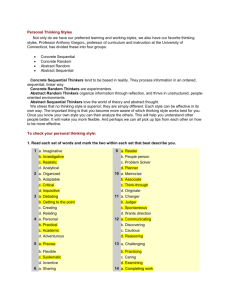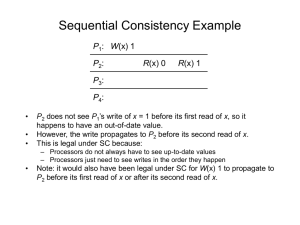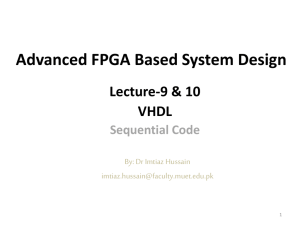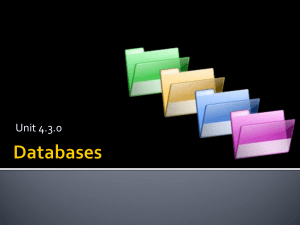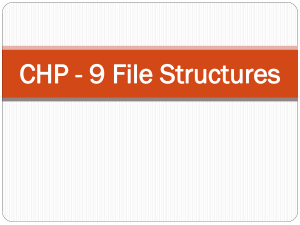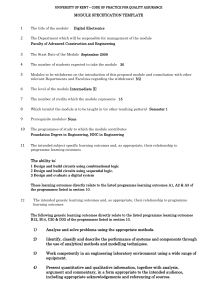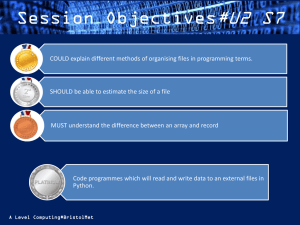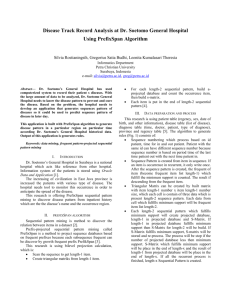Multiple Land Use Framework
advertisement
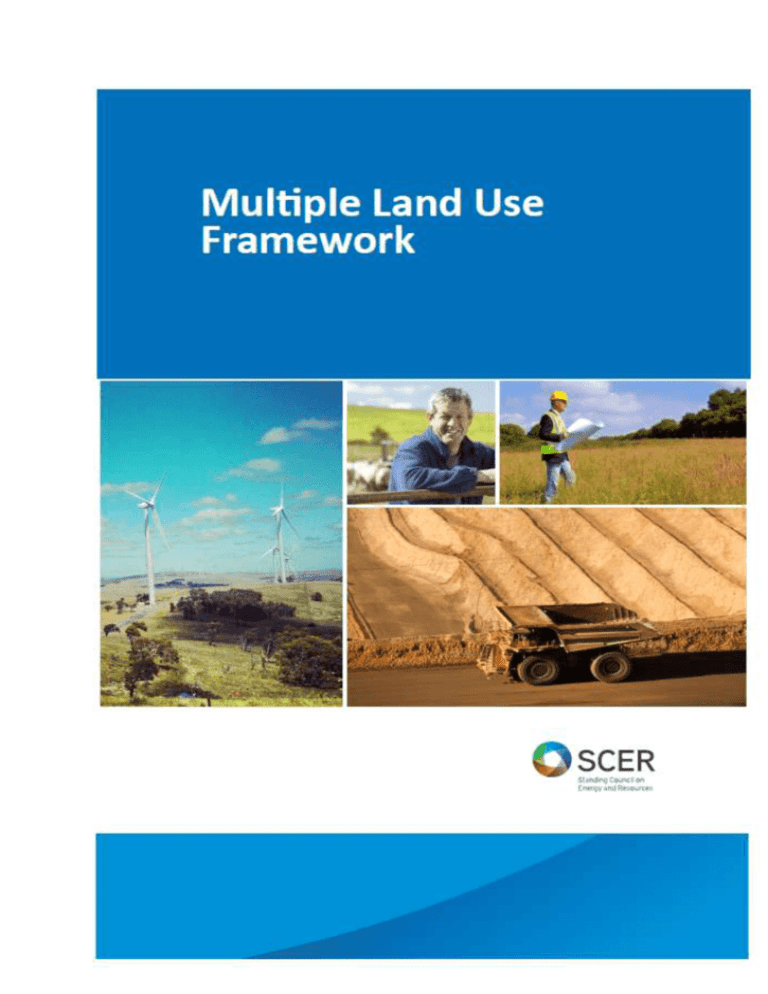
Multiple Land Use Framework Introduction The Multiple Land Use Framework (MLUF) has been developed to address challenges arising from competing land use, land access and land use change1. The aim of the MLUF is to enable government, community and industry to effectively and efficiently meet land access and use challenges, expectations and opportunities. The MLUF is intended to be used where land access and land use conflict has the potential, real or perceived, to arise. Whilst it has been developed with the minerals and energy resources sectors in mind, the underlying concept can extend to all sectors, interests and values including but not limited to agriculture, minerals and energy resources, environmental, heritage, cultural, tourism, infrastructure, community and forestry. The framework supports the ability of local and regional communities and governments to maximise land use in a flexible, environmentally sustainable manner over time. Conceptually, the objective is to maximise the net benefits to present and future generations from a combination of land uses which benefit the wider community, now or in the future. The MLUF provides a consistent approach to land use development and planning across all jurisdictions. It is intended to be flexible and adaptive to resolving land use tensions and conflicts across the short to long term. The MLUF consists of four outcomes, eight guiding principles and nine components. It combines adaptive capabilities (leadership, partnerships, planning, engagement, information and continuous improvement) and technical solutions (assessment and approvals processes underpinned by sound scientific and engineering guidance and practice). The MLUF is designed to operate within established regulatory and policy frameworks relating to land ownership, usage and access. The principles and components will not alter existing land rights assigned under Crown land, freehold, native title and pastoral leases. However, the framework may influence the way in which rights and obligations related to land tenure are imposed on users by State and Territory Governments. With this in mind, it is at the complete discretion of jurisdictions to determine the scope of their individual Framework and the nature in which they will implement it, so long as it continues to align with the fundamental concept of the MLUF. Multiple and Sequential Land Use Multiple land use is where land is used for different purposes simultaneously and sustainably with a view to maximise the benefits for all Australians. The objective is to retain options for current and future use to maximise the net benefits of all forms of land use for present and future generations. Sequential land use involves different use of land over time. It may include a return to a former use or the development of an alternative land use. 1 The MLUF was developed by the Standing Council on Energy and Resources for the minerals and energy resources sector. Exposure of the draft framework to key stakeholders from other industry and land uses indicate the framework is applicable to land use change situations that do not involve the mineral and energy resources sector. Guiding Principles The MLUF guiding principles underpin key areas of activity required to achieve multiple and sequential land use outcomes. The principles should be embodied into the mindset of governments, community and industry in land use planning, policy and development. Best use of resources - Maximise the social, economic, environmental and heritage values of land use for current and future generations. Coexistence – The rights of all land users are recognised and their intentions acknowledged and respected. Ensure land use decision making does not exclude other potential uses without considering the benefits and consequences for other land users and the wider Australian community. Strategic planning – Inter-governmental planning to recognise community expectations and capacity to adapt to land change. Effective planning gives greater certainty to industry. Tailored participation of communities and landholders – Directly affected landholders should be informed and consulted on multiple land use options and potential for coexistence to promote a greater understanding of mutual benefits and to resolve problems. Engagement and information – Open and constructive debate and analysis of different multiple land use options. Stakeholders should be willing to listen and appreciate the views, concerns and needs of all land users. Decision making and accountability – Risk-based approach in the assessment of land use capability, including the benefits and consequences. Clear accountability and governance around the decision-making process. Efficient processes – Streamlined, transparent and consistent approvals processes. Those who are responsible for the planning, assessment and approvals processes are clearly identified. Accessible relevant information – Easy access to accurate information regarding land capability, and examples of multiple and sequential land uses. Components The MLUF defines areas of activity, supported by the overarching principles (outlined above), that must be part of successful multiple and sequential land use: Leadership, Facilitation and Coordination - Strong leadership from government, industry and the community is central to successful multiple/sequential land use outcomes. Articulate the broad areas of responsibilities of government, industry and the community in terms of facilitating and leading the required changes to optimise multiple and sequential land use. Planning – Seek clarity regarding governments’ objectives and intentions. Describe the optimal approach to enable regions to benefit from land use change. Partnerships - Partnerships between industry and affected stakeholders play an important role in achieving mutually beneficial multiple and sequential land use outcomes. Identify what needs to be done in order for regional communities to be prepared for land use changes. Extensive stakeholder consultation assists decision making and avoids inappropriate development and/or exclusion of land from other potential uses. Engagement – Early engagement to enable stakeholders to clearly understand any proposed land use activity. Progress a tripartite approach, with government, industry and community working, to resolving policy, planning and investment conflict. Guidance as to how to engage with key stakeholders with an interest or involvement in land access and usage issues. Information – Education and adoption of evidence-based approaches is an important feature of successful multiple land use planning approaches. Inform the broader community, industry and media about the importance of land access and land use to the future viability of all industries and the ongoing sustainability of regions. Inform media and industry about what governments Page 3 of 6 are doing to protect the public interest with respect to regulating industry and protecting social and environmental values. Assessments and Approvals – Project approvals are streamlined through applying risk-based approaches that are based on best available science, evidence and sustainable development principles. Transparent and consistent approvals processes which account for multiple and sequential land use, and identify related issues such as water, heritage and cultural values. Monitoring and Compliance – Improvement in the transparency and understanding of how Government/s ensure industry complies with conditions/regulations set to protect the public interest. Increased confidence in the regulator through efficiency in enforcement. Continuous Improvement – Drawing on past experiences in decision making will improve multiple and sequential land use outcomes. Outline the necessary coordination of investment and the resulting outputs of the investment in the areas of activity, to better understand the cumulative effects of land use change and development across economic environmental and social dimensions. Sharing and Collaboration - Collaboration between organisations such as government and industry bodies can support sharing of data and information, and quality assurance, accuracy and correct application. Provide mechanisms and opportunities for government, industry and community to share land related information to identify potential issues and opportunities for multiple and sequential land use outcomes. Page 4 of 6 Diagrammatic representation of the MLUF concept (Sinclair Knight Merz 2012) Page 5 of 6 Desired Outcomes Outcomes sought by the MLUF: Shared commitment by government, industry and the community to multiple and sequential land use - Minimise incidences of conflict over land use by improved ability to recognise differing needs and benefits to all stakeholders early, then using a risk-based approach to mitigate adverse impacts and realise mutual benefits. Better informed public discourse - Increased transparency and consistency in land use decisions, public access to relevant information, improved understanding of land access regulations relevant to each activity, as well as recognising the benefits of coexistence and collaboration through multiple land use approaches. Merit based land use decisions - Ensure land is not designated for a single use only, excluding other potential uses, without fully understanding the consequences. Providing certainty for industry and improved community confidence in land use decisions. Deliver acceptable outcomes for affected communities and landholders – Promote the view that multiple and sequential land use approaches can benefit all stakeholders and engender greater confidence in, and positive engagement by, communities and land holders affected by industry developments. Next Steps Key stakeholder engagement on the MLUF across government agencies at the Commonwealth, State and Territory levels and with key industries including agriculture, demonstrates broad support for the implementation of the MLUF. The value of the framework has been recognised during inter and intra government discussions on current land access and use challenges. Resource agencies have committed to the implementation of the MLUF with learnings shared through the Standing Council on Energy and Resources (SCER). The MLUF is designed to operate within established regulatory and policy frameworks relating to land ownership, usage and access. The principles and components will not alter existing land rights assigned under Crown land, freehold, native title and pastoral leases. However, the framework may influence the way in which rights and obligations related to land tenure are imposed on users by State and Territory Governments. The MLUF is a fresh approach to changes in land use. By reducing tensions that can arise between stakeholders, we achieve a better economic, social and environmental outcome that leads to sustainable outcomes for future generations. The State and Territories resource agencies will be the driver for designing the implementation model. There is already widespread understanding across government and the Multiple Land Use Framework terminology is being used. We have an opportunity to help resolve land use issues that support the co-existence of various land uses in a sustainable and profitable manner. Page 6 of 6


